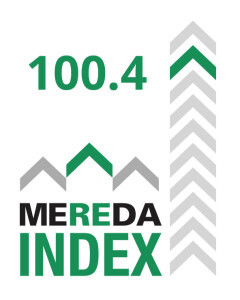The MEREDA Index hits all-time high
 Last week, the Maine Real Estate & Development Association (MEREDA), released a report showing that the state’s number two driver of GDP has hit a record high, coming in at 100.4.
Last week, the Maine Real Estate & Development Association (MEREDA), released a report showing that the state’s number two driver of GDP has hit a record high, coming in at 100.4.
“Maine’s real estate market is led by the commercial sector, with historic highs besting pre-recession performance. Real estate developers are contributing to the economic and cultural landscape in robust, meaningful ways,” said Paul Peck, president of the board at MEREDA.
Not only has the MEREDA Index showed continuing gains, rising by 2.4% since the third quarter of 2017 and 4% over the twelve months since the first quarter of 2017, it has also surpassed pre-recession levels for the first time.
“Particularly during the last two quarters, the MEREDA Index has been driven primarily by rising prices in both the residential and commercial markets. The rising prices are supporting expanded supply of residential units, but commercial volume has not been as strong,” wrote Dr. Charles Colgan, an economist who compiles the MEREDA Index on behalf of the organization.
The Commercial Component hit 107.13, which is the most robust of the three metrics that comprise the Index. It was up by 3.1% in the past two quarters and 2.2% over the past year, but there was a mixture of trends. Colgan noted that commercial sales price per square foot has risen significantly over both the past two quarters (31.7%) and over the past year (21.1%), but the metrics for leasing rates has declined by 5.6% over the past year and both the volume of commercial transactions and the square footage of commercial properties have declined over the past year by 7.1% and 10.5% respectively.
The Residential Component came in at 95.04. According to Colgan, the seasonally adjusted median house price rose 6.9% in the past two quarters and 9.5% over the past year. Permits for new single and multi-family construction are estimated by Moody’s Analytics to show strong growth of over 16% on a seasonally adjusted basis over the last two quarters, suggesting the rising prices are calling forth additional supply. The metrics for mortgage originations (up 5%) and sales of existing units (up 4.2%) also showed strong growth.
The Construction Component dipped a bit to 88.2, but included a rise in residential permits, which suggests additional supply in the residential market will be coming in the months ahead.
A written report and video presentation of The MEREDA Index, both with commentary from four industry experts, are available at http://www.mereda.org/currentindex.php.
Here is a look at trends from The MEREDA Index through the years:
| Date range | The MEREDA Index | Residential Component | Commercial Component | Construction Component |
| 2006Q1 | 100.00 | 100.00 | 100.00 | 100.00 |
| 2006Q2 | 98.24 | 95.95 | 99.54 | 100.96 |
| 2006Q3 | 93.95 | 86.30 | 98.85 | 100.00 |
| 2006Q4 | 91.71 | 88.15 | 93.25 | 98.30 |
| 2007Q1 | 91.21 | 91.00 | 89.90 | 98.62 |
| 2007Q2 | 89.09 | 85.85 | 89.87 | 98.09 |
| 2007Q3 | 86.49 | 83.17 | 86.78 | 98.30 |
| 2007Q4 | 84.33 | 73.73 | 90.00 | 98.41 |
| … | … | … | … | … |
| 2013Q1 | 75.50 | 66.68 | 81.56 | 80.47 |
| 2013Q3 | 78.42 | 73.05 | 82.00 | 81.95 |
| 2014Q1 | 81.51 | 70.19 | 90.41 | 82.27 |
| 2014Q3 | 85.86 | 74.48 | 95.49 | 83.23 |
| 2015Q1 | 91.38 | 73.59 | 107.31 | 82.91 |
| 2015Q3 | 98.03 | 84.16 | 111.64 | 85.46 |
| 2016Q1 | 97.67 | 83.57 | 110.92 | 87.79 |
| 2016Q3 | 98.45 | 87.34 | 109.62 | 87.05 |
| 2017Q1 | 96.54 | 87.92 | 104.84 | 89.49 |
| 2017Q3 | 98.07 | 92.89 | 103.86 | 89.81 |
| 2018Q1 | 100.40 | 95.04 | 107.13 | 88.22 |
This edition of The MEREDA Index is supported by: SMRT Architects Engineers and XPress Copy.
